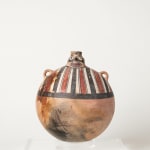







Nazca Culture 100 BC-800 AD
Tunic wearing ceramic, Circa. 500AD
Ceramic
27,5 x 20,5 x 17 cm
10'8" x 8" x 6'6" in.
10'8" x 8" x 6'6" in.
NAZ0007
Copyright of Paul Hughes Fine Arts
Further images
-
(View a larger image of thumbnail 1
)

-
(View a larger image of thumbnail 2
)

-
(View a larger image of thumbnail 3
)

-
(View a larger image of thumbnail 4
)

-
(View a larger image of thumbnail 5
)

-
(View a larger image of thumbnail 6
)

-
(View a larger image of thumbnail 7
)

-
(View a larger image of thumbnail 8
)

This personage wears a striped Tunic on a pottery canteen with tiny twin pierced handles, presumably for suspension, and a slightly flared cylindrical spout. The Nazca culture is well known...
This personage wears a striped Tunic on a pottery canteen with tiny twin pierced handles, presumably for suspension, and a slightly flared cylindrical spout. The Nazca culture is well known for its beautiful polychromatic pottery, painted with at least 15 distinct colours. The shift from post-fire resin painting to pre-fire slip painting marked the end of Paracas-style pottery and the beginning of Nazca-style pottery. The use of pre-fire slip painting meant that a great deal of experimentation took place with the purpose to know which slips produce specific kinds of colour. Major pottery shapes include bowls, cups, vases, effigy forms, and mythical creatures. Archaeologists have excavated highly valued polychromatic potteries among all classes of Nazca society, illustrating that it was not just the elite that had access to them.
"The aim of art is not the representation of the external appearance of things, but to capture their spiritual essence. For that - and not external mannerism or detail work - is the true reality." Aristotle.
"The aim of art is not the representation of the external appearance of things, but to capture their spiritual essence. For that - and not external mannerism or detail work - is the true reality." Aristotle.
Join our mailing list
* denotes required fields
We will process the personal data you have supplied in accordance with our privacy policy (available on request). You can unsubscribe or change your preferences at any time by clicking the link in our emails.